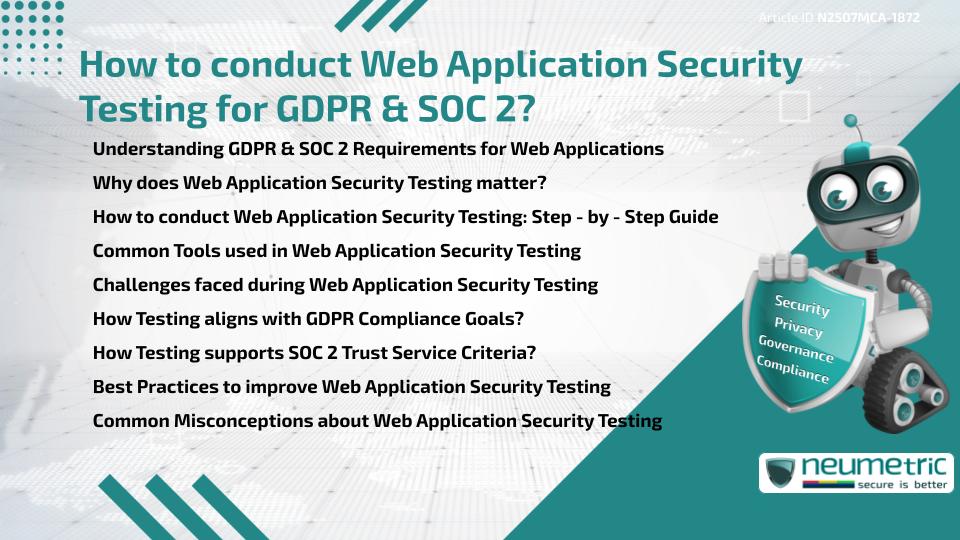Table of Contents
ToggleIntroduction
With increasing digital transformation, web applications have become essential for businesses across industries. But this growth comes with security Risks & Compliance responsibilities. Frameworks like the General Data Protection Regulation [GDPR] & Service Organisation Control 2 [SOC 2] set clear standards for Data Privacy & security. In this context, understanding How to conduct Web Application security testing becomes critical for organisations aiming to maintain Customer Trust & legal Compliance.
This article explores how to align Web Application testing with GDPR & SOC 2, how it works, why it matters & what to avoid.
Understanding GDPR & SOC 2 Requirements for Web Applications
GDPR is a Regulation in the European Union focused on Personal Data Protection. Any Web Application that collects or processes data from EU residents must comply. Key requirements include data minimisation, consent management, breach notifications & encryption.
SOC 2 is a Compliance Standard primarily followed in the United States. It evaluates how companies handle Customer Data based on five Trust Service Criteria: Security, Availability, Processing Integrity, Confidentiality & Privacy.
Both GDPR & SOC 2 require proactive security practices & knowing How to conduct Web Application security testing is a foundational step to fulfilling those demands.
Why does Web Application Security Testing matter?
Web Application security testing helps organisations detect Vulnerabilities that could lead to data breaches, reputational damage or non – Compliance penalties. Security flaws such as Cross – Site Scripting, SQL Injection, Broken Authentication or Insecure APIs are often exploited by attackers.
Knowing How to conduct Web Application security testing ensures that these Threats are mitigated before they can be exploited. It’s not just about identifying problems but about showing due diligence & fulfilling legal & contractual obligations.
How to conduct Web Application Security Testing: Step – by – Step Guide
Learning How to conduct Web Application security testing involves a structured approach. Here is how to do it effectively:
1. Define the Scope
Start by identifying which components of the application will be tested-frontend, backend, APIs or User authentication systems.
2. Choose Testing Methodology
Use a mix of manual & automated testing. Techniques include Static Application Security Testing [SAST], Dynamic Application Security Testing [DAST] & Interactive Application Security Testing [IAST].
3. Use Trusted Tools
Employ tools like Burp Suite, OWASP ZAP or Nikto. These help simulate attacks & scan for weaknesses in real time.
4. Simulate Real – World Attacks
Carry out ethical hacking or Penetration Testing to mimic Threat actors’ behaviour.
5. Document Findings & Fix Issues
Provide clear documentation of discovered Vulnerabilities & ensure remediation actions are tracked & completed.
6. Retest & Monitor
After fixes, perform regression testing. Continuously monitor the application for new Threats.
Knowing How to conduct Web Application security testing means integrating these steps into the Software Development Lifecycle [SDLC], not treating them as a one – time exercise.
Common Tools used in Web Application Security Testing
Selecting the right tools simplifies How to conduct Web Application security testing. Some widely used tools include:
- Burp Suite – ideal for manual testing & advanced attack simulations
- OWASP ZAP – free, open – source scanner for detecting security Risks
- Nikto – lightweight web server scanner
- Acunetix – for deep Vulnerability scanning
- Nmap – used to discover open ports & weak configurations
Challenges faced during Web Application Security Testing
Even with proper planning, several challenges can arise:
- Limited testing time due to release cycles
- Lack of in – house security expertise
- False positives or undetected Vulnerabilities
- Inconsistent documentation of issues
Understanding How to conduct Web Application security testing helps mitigate these issues by establishing repeatable & scalable processes.
How Testing aligns with GDPR Compliance Goals?
GDPR Compliance demands confidentiality, integrity & availability of Personal Data. Web Application testing supports these goals through:
- Identifying Weak Access Controls
- Ensuring secure data transmission
- Verifying proper consent capture & encryption
By knowing How to conduct Web Application security testing, organisations can better demonstrate Compliance during Data Protection audits.
How Testing supports SOC 2 Trust Service Criteria?
For SOC 2, security testing ties directly to the Trust Service Criteria. Testing verifies:
- Logical Access Controls
- Change management protocols
- Data Encryption & backup mechanisms
- Detection of unusual system activity
Mastering How to conduct Web Application security testing makes it easier to generate Audit – ready evidence for SOC 2 reporting.
Best Practices to improve Web Application Security Testing
To elevate the results of your testing efforts:
- Integrate testing early in development (Shift Left Testing)
- Maintain clear documentation for every test
- Validate Third Party components & libraries
- Train developers in secure coding
- Automate wherever feasible without replacing human oversight
Embedding these practices helps teams stay consistent with How to conduct Web Application security testing.
Common Misconceptions about Web Application Security Testing
Misunderstandings about testing often weaken its impact:
- “One test is enough” – Security is continuous
- “Automated tools catch everything” – They do not
- “Compliance equals security” – Not always
Avoiding these assumptions is central to truly understanding How to conduct Web Application security testing.
Takeaways
- Web Application security testing is essential for GDPR & SOC 2 Compliance.
- A structured process helps identify, fix & prevent Vulnerabilities.
- Choosing the right tools & following Best Practices improves outcomes.
- Testing should be ongoing & integrated into your application lifecycle.
FAQ
What is the first step in How to conduct Web Application security testing?
The first step is to define the scope of the testing, identifying which components & functionalities of the Web Application are to be tested.
Can automated tools alone handle How to conduct Web Application security testing?
No. While tools are helpful, human – led testing is crucial for identifying complex Vulnerabilities & logic flaws.
How often should one conduct Web Application security testing?
Testing should be conducted regularly—at least quarterly—and after major updates or deployments.
Does SOC2 Compliance mandates Web Application security testing?
Yes. Testing supports multiple Trust Service Criteria in SOC 2 & serves as evidence for auditors.
How does Web Application testing help with GDPR?
It ensures Personal Data is handled securely & helps demonstrate Compliance during regulatory Reviews.
Can testing help reduce penalties under GDPR?
Yes. Demonstrating proactive security efforts can mitigate fines in case of a data breach.
Is manual testing still relevant in modern security testing?
Absolutely. Manual testing complements automation & helps discover logic – based or context – specific Vulnerabilities.
Who should be responsible for How to conduct Web Application security testing?
Ideally, a dedicated security team or certified external experts with deep knowledge of application Threats & Compliance standards.
Need help?
Neumetric provides organisations the necessary help to achieve their Cybersecurity, Compliance, Governance, Privacy, Certifications & Pentesting goals.
Organisations & Businesses, specifically those which provide SaaS & AI Solutions, usually need a Cybersecurity Partner for meeting & maintaining the ongoing Security & Privacy needs & requirements of their Clients & Customers.
SOC 2, ISO 27001, ISO 42001, NIST, HIPAA, HECVAT, EU GDPR are some of the Frameworks that are served by Fusion – a centralised, automated, AI – enabled SaaS Solution created & managed by Neumetric.
Reach out to us!





